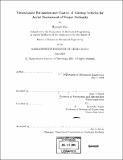| dc.contributor.advisor | John J. Deyst. | en_US |
| dc.contributor.author | Ahn, Hyungil, 1976- | en_US |
| dc.contributor.other | Massachusetts Institute of Technology. Dept. of Mechanical Engineering. | en_US |
| dc.date.accessioned | 2005-06-02T19:13:31Z | |
| dc.date.available | 2005-06-02T19:13:31Z | |
| dc.date.copyright | 2004 | en_US |
| dc.date.issued | 2004 | en_US |
| dc.identifier.uri | http://hdl.handle.net/1721.1/17929 | |
| dc.description | Thesis (S.M.)--Massachusetts Institute of Technology, Dept. of Mechanical Engineering, 2004. | en_US |
| dc.description | Includes bibliographical references (leaves 141-142). | en_US |
| dc.description.abstract | Recent experiences indicate there are limitations to the surveillance capability of high-value long-distance standoff ISR (Intelligence, Surveillance, Reconnaissance) platforms such as the latest observation satellites and unmanned aircraft. The high-tech systems in the platforms are often influenced by weather conditions or defeated by low-tech adversaries such as foliage, caves and concealment. These limitations indicate that close-in, on-the-ground sensor networks are essential parts for powerful ISR capability. However, it is hard to place ground sensors at planned specific locations. For example, certain sensor nodes may be required to be located on rooftops or tree canopies. Therefore, it is critical to deliver the sensors with high precision and reliability. The current UAV (Unmanned Aerial Vehicle) technologies may give a key solution to sensor deployment because they have shown the capability for delivering a variety of payloads. The delivery utilizing UAVs may also minimize cost and complexity which are critical factors in real missions where sensor networks may consist of hundreds of sensors. In this thesis, A way of utilizing UAVs for precision delivery of sensor nodes is suggested, a prototype of a precision airdrop vehicle (PDV) is suggested, and a vision-based estimation and control system design, using both an IMU (Inertial Measurement Unit) and a vision system to achieve precision airdrop deployment is described. The design was also tested in a hardware-in-the-loop-simulation (HILSIM) framework. Good performance and reliability of the design were demonstrated in HILSIM tests. From HILSIM tests, it was shown that the PDV launched from a carrier UAV at a speed of about 20 m/sec and at an altitude of about 350 meters, could be guided | en_US |
| dc.description.abstract | (cont.) to a target point with a maximum error of 5 meters, if the launching position could be estimated to within a maximum error of 50 meters from the ideal launching position. This implies that the exact target position and the exact launching position are not necessary for precision node delivery. | en_US |
| dc.description.statementofresponsibility | by Hyungil Ahn. | en_US |
| dc.format.extent | 142 leaves | en_US |
| dc.format.extent | 6028704 bytes | |
| dc.format.extent | 6028512 bytes | |
| dc.format.mimetype | application/pdf | |
| dc.format.mimetype | application/pdf | |
| dc.language.iso | eng | en_US |
| dc.publisher | Massachusetts Institute of Technology | en_US |
| dc.rights | M.I.T. theses are protected by copyright. They may be viewed from this source for any purpose, but reproduction or distribution in any format is prohibited without written permission. See provided URL for inquiries about permission. | en_US |
| dc.rights.uri | http://dspace.mit.edu/handle/1721.1/7582 | |
| dc.subject | Mechanical Engineering. | en_US |
| dc.title | Vision-based estimation and control of airdrop vehicles for aerial deployment of sensor networks | en_US |
| dc.type | Thesis | en_US |
| dc.description.degree | S.M. | en_US |
| dc.contributor.department | Massachusetts Institute of Technology. Department of Mechanical Engineering | |
| dc.identifier.oclc | 56803391 | en_US |
